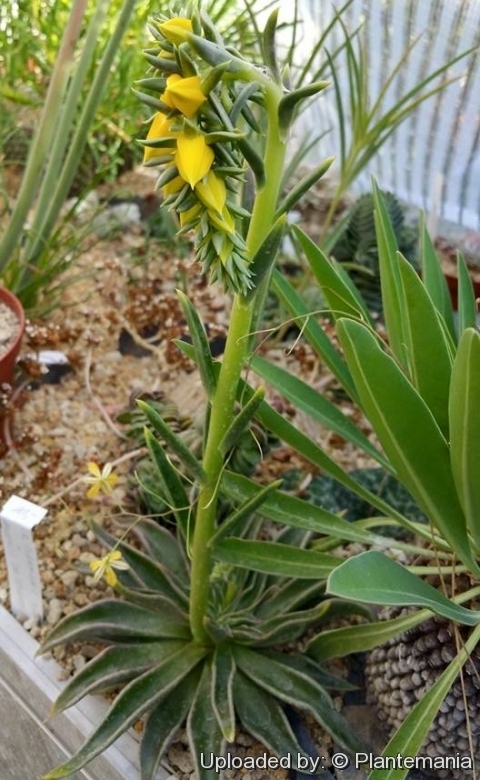




Your support is critical to our success.

Origin and Habitat: Echeveria luteaSN|33586]]SN|33586]] has a fairly wide range in the San Luis Potosi and Hidalgo, Mexico.
Habitat and ecology: This species grows on limestone on eastern exposures.
Synonyms:
- Echeveria lutea Rose
Echeveria lutea Rose
J. Wash. Acad. Sci. 1: 268 1911.
Synonymy: 2
- Echeveria lutea Rose
- Echeveria lutea var. fuscata E.Walther
ENGLISH: Yellow Echeveria
Description: Echeveria luteaSN|33586]]SN|33586]] is an attractive glabrous, acaulescent, species with lovely yellow flowers. It is usually stemless, and has solitary or few clustered rosettes of almost linear, acuminate leaves less than 5 cm long and about 1 cm wide, yellowish-green heavily tinged with reddish-brown. The leaves enrol at the margins, forming a deep hollow in the middle of the leaf on the upper surface with the green lower surface facing up, giving the plant a distinct bi-coloured look. This colouration and rolled leaf are most prominent when water-stressed or when grown in full sun. The inflorescence stalk grows up to 75 cm high, and has numerous bracts resembling the rosette leaves but getting smaller towards the top. The flowers are some of the most outstanding and unusual in the genus by being bright buttercup yellow. It is somewhat variable.
Root: Thickened
Stem: Very short, less than 5 cm long, 1 - 2 cm in diameter, sparsely branching.
Rosettes: 8-12 cm in diameter, sparingly soboliferous or solitary.
Leaves: Basai leaves densely rosulate ( up to 25 per rosette), ascending, thickish, linear-elliptic to oblanceolate (almost linear), long-acuminate, tip acute, upcurving, deeply channelled above, 4-5(-10) cm long, 8-18(-30) mm wide, 3-7 mm thick, with upturned margins and upcurved apex,obscurely keeled beneath, grey-green, green, yellowish-green, brownish-green or reddish-purple. Stem-leaves (bracts) linear, semiterete, shallowly concave above, 4-5(-6.5) cm long but getting smaller towards the top.
Inflorescences: Usually solitary, unbranched, to 20 - 75 cm tall, apical portion strongly deflected before anthesis. Stalk straight, rising well above the foliage, racemose or 2-branched, arching over towards the tip so that the clear yellow flowers strongly point downwards before anthesis, each branch with 12 or more flowers. Pedicels very short (less than 2 mm long) or none, 2-4 mm thick.
Flowers: Buttercup yellow sometime tipped orange. Sepals subequal, widely spreading to somewhat reflexed, longest to 13 mm Long. Corolla strongly pentagonal, conoid-cylindroid, 12-17 mm long, 8-12 mm in diameter near the base, 3 -5 mm at the mouth, yellow. Petals somewhat spreading at tips, with a well developed basal hollow. Nectaries reniform, truncate, to 2 mm wide.
Blooming season: The flower inflorescence appears during summer (in habitat from July onward).
Fruit: With 5-follicled that open alone when ripening and contain more than 50 seeds each.
Chromosome number: n = 12.
Bibliography: Major references and further lectures
1) Eggli, Urs “Illustrated Handbook of Succulent Plants, Crassulaceae Illustrated Handbook of Succulent Plants.” Springer, Berlin 2002
2) Eric Walther “Echeveria” California Academy of Sciences, 01 June1972
3) L. Carruthers, R. Ginns “Echeverias: A Guide to Cultivation and Identification of the Popular American Succulents” Arco Publishing Company, 1973
4) “North American Flora”, Volume 22 New York Botanical Garden., 1905
5) San Marcos Growers contributors “ Echeveria lutea - Yellow Echeveria” San Marcos Growers <http://www.smgrowers.com>. Web. 11 Jan. 2017.
6) Meyrán García, J. & L. López Chavez. “Las Crasuláceas de México”. Sociedad Mexicana de Cactología A.C. México. 234 pp. 2003.
7) Reyes Santiago, J., Islas Luna M. A. & O. González Zorzano.“Guía práctica de propagación y cultivo de las especies del género Echeveria. También conocidas como conchitas, lenguas de vaca, magueyitos, rosetas y tememetla.” SAGARPA-SNICS-SINAREFI-INSTITUTO DE BIOLOGÍA (UNAM)-JARDÍN BOTÁNICO DEL INSTITUTO DE BIOLOGÍA (UNAM)-RED ECHEVERIA-UNAM-GRUPO MULTI. 111 pp. 2014.
Cultivation and Propagation: Echeveria lutea is rather difficult to maintain, being native to hot arid areas. In habitat this species is a shade or only part sun growing plant but in cooler coastal climates it will likely take full sun and the leaf colouration will likely be redder. This coloration and rolled leaf are most prominent when water-stressed or when grown in full sun - with regular irrigation shade grown plants flatten out a bit and are greener. Plants cultivated in containers can tolerate sun to shade but - generally speaking - the more light plants gets the better they will display theyr colours and shape. However, when moving plants from lower light conditions into full sun, be wary of sun scorch, most easily avoided by ensuring plants are well-watered before moving them on a cloudy day. They can tolerate extended dry periods and survive drought without the need for watering, but they will grow stronger if they receive adequate moisture during their growing season, but never allowing the plant to remain waterlogged (root rot sensitive). Use a very porous soil, which will allow quick drainage. Slow release fertilisers with a low to moderate nitrogen content are adequate for the spring and summer growing seasons, and additional fertiliser applications would not required until spring. Good air movement is important for minimising pest and disease risks, and avoiding excessive humidity in cool winter conditions is important to successfully growing Echeveria in the nursery environment. It can tolerate light frosts, but it is best overwintered at 5-10 °C.
With the cooler autumn temperatures tending to make their foliage colours become more intense than those of the active summer growing season.
Aphids like this plant (and all flowering Echeverias).
Propagation: This plant is propagated by seeds of by removal of offset (if available) a. Let the cut ends dry for overnight or up to a week before potting up. Some growers recommend planting immediately into dry growing media, watering only after roots form.
| Your Actions | |
|---|---|
| Back to Echeveria index | |
| Back to Crassulaceae index | |
 |
Back to Succulents Encyclopedia index |
Privacy stantement - Terms and conditions - How to cite - About us - Feedback - Donate



